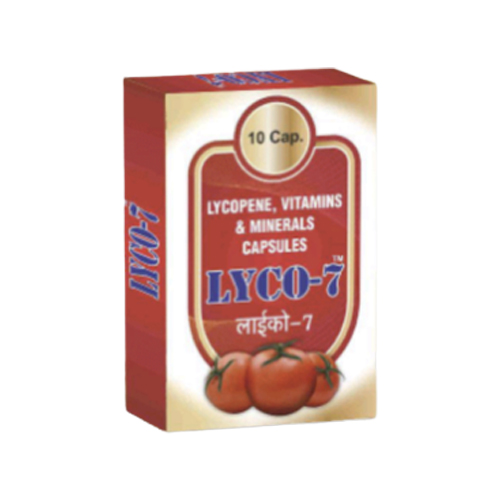Lyco-7

technical specification
Formulated with the ingredients such as Omega- 3 Fatty Acids, Coenzyme Q10, Calcium, Vitamins, Zinc and Wheat Germ Oil, it helps ailments related to the heart such as Congestive heart failure (CHF) and chest pain. It is also useful in regulating blood pressure and blood sugar level.
Lycopene is a naturally occurring chemical that gives fruits and vegetables a red color. It is one of a number of pigments called carotenoids. Lycopene is found in tomatoes, watermelons, red oranges, pink grapefruits, apricots, rosehips, and guavas. In North America, 85% of dietary lycopene comes from tomato products such as ketchup, tomato juice, sauce, or paste. A serving of fresh tomatoes contains between 4 mg and 10 mg of lycopene, while one cup (240 mL) of tomato juice provides about 20 mg. Processing raw tomatoes using heat (in the making of tomato juice, tomato paste or ketchup, for example) actually changes the lycopene in the raw product into a form that is easier for the body to use. The lycopene in supplements is about as easy for the body to use as lycopene found in food.
Lycopene is a naturally occurring chemical that gives fruits and vegetables a red color. It is one of a number of pigments called carotenoids. Lycopene is found in tomatoes, watermelons, red oranges, pink grapefruits, apricots, rosehips, and guavas. In North America, 85% of dietary lycopene comes from tomato products such as ketchup, tomato juice, sauce, or paste. A serving of fresh tomatoes contains between 4 mg and 10 mg of lycopene, while one cup (240 mL) of tomato juice provides about 20 mg. Processing raw tomatoes using heat (in the making of tomato juice, tomato paste or ketchup, for example) actually changes the lycopene in the raw product into a form that is easier for the body to use. The lycopene in supplements is about as easy for the body to use as lycopene found in food.
